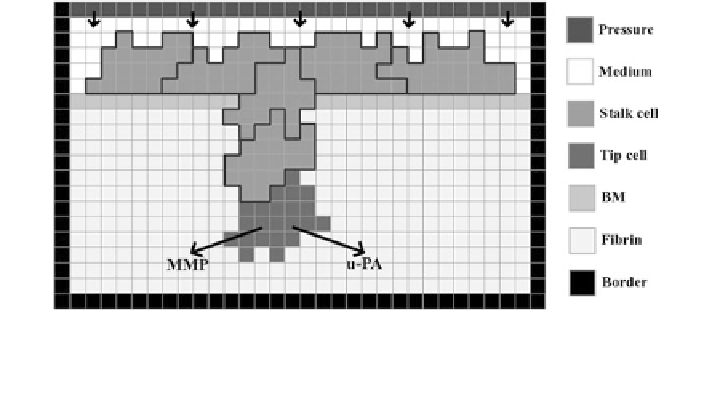Biomedical Engineering Reference
In-Depth Information
Fig. 4 Schematic representation of the cellular potts model. The different colors depict the types
defined in the sprouting model. The tip cell secretes MMP and u-PA (large arrows) to degrade
the extracellular matrix and the small arrows on top represent a the small chemorepulsive
pressure on the cells
Potts model [
39
,
40
] describes the shape, behavior and movement of the cells. The
tip cell will secrete proteolytic enzymes, matrix metalloproteinases (MMPs) and
u-PA, to degrade the BM and fibrin respectively. The endothelial cells are attracted
to higher concentrations of fibrin, which is also modeled as a concentration field,
and migrate into the created space to form a sprout. On top, a local chemorepulsive
field exerts a small pressure on the endothelial cells in the monolayer to keep them
flattened and well connected. A schematic overview of the model is given in
Fig.
4
.
The Cellular Potts model represents cells, BM and fibrin as patches of grid sites
(Fig.
4
), which are differentiated by types
ð
s
Þ
with specific properties and
behaviors. Cells can migrate by the addition and removal of grid sites at their cell
membranes, which can be seen as extensions or retractions of pseudopodia. A grid
site
ð
x
Þ
is added or removed by copying the contents of a neighboring grid site
ð
x
0
Þ
(Fig.
5
). Whether such a copy is allowed depends on an energy function, which
summarizes the balance of forces resulting from cell behavior: E
¼
E
contact
þ
E
shape
þ
E
connectivity
:
The change in this local energy (DE) for a certain copy is a
measure for its favorability. Energy decreasing copies will always be accepted;
while a copy that increases energy will be accepted according to a Boltzmann
probability function: P
accept
ð
DE
Þ¼
e
DE
:
The ability to accept copies that cost
l
energy
resembles active
cell motility, with the parameter l a cell motility
parameter.
Adhesion or repulsion by cells is modeled by contact energy between types
ð
J
s1
;
s2
Þ
: lower energies resemble stronger adhesions between types. The model is
surrounded by a border (Fig.
4
) which has high contact energy with cells to
prevent them from sticking to the edges. The overall contact energy sums the
contact energies between cells and between cells and their surrounding:

Search WWH ::

Custom Search